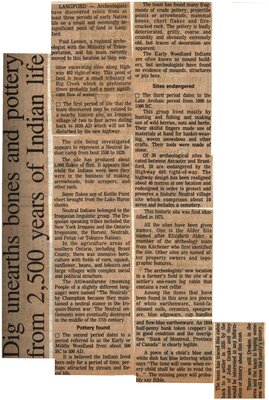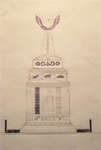"Dig Unearths Bones and Pottery from 2,500 Years of Indian Life"
- Publication
- Brantford Expositor, 1989
- Full Text
- Dig unearths bones and pottery from 2,500 years of Indian life
LANGFORD - Archeologists have discovered relics from at least three periods of early Native life on a small and seemingly insignificant point of land in Langford.
Paul Lennox, a regional archeologist with the Ministry of Transportation, and his team recently moved to this location as they continue excavating sites along Highway 403 right-of-way. This point of land is near a small tributary of Big Creek which in prehistoric times probably had a more significant flow of water.
The first period of life that the team discovered may be related to a nearby historic site, an Iroquois village of two to four acres dating back to 1620 AD which will not be disturbed by the new highway.
The site being investigated appears to represent a Neutral Indian camp from bout 1550 to 1620.
The site has produced about 5,000 flakes of flint. It appears that while the Indians were here they were in the business of making arrowheads, hide scrapers, and other tools.
Neutral Indians belonged to the Iroquoian linguistic group. The Iroquoian speaking tribes included the New York Iroquois and the Ontario Iroquoians, the Hurons, Neutrals, and Petun (or Tobacco Nation).
In the agriculture areas of southern Ontario, including Brant County, there was intensive horticulture with fields of corn, squash, sunflower, beans, and tobacco and large villages with complex social and political structure.
The Attiwandarons (meaning People of a slightly different language) were named "The Neutrals" by Champlain because they maintained a neutral stance in the Iroquois-Huron war. The Neutral settlements were eventually destroyed in the middle of the 17th century.
Pottery foundThe second period dates to a period referred to as the Early or Middle Woodland from about 500 BC to 500 AD.
It is believed the Indians lived here only for a period of time, perhaps attracted by stream and forest life.
The team has found many fragments of crude pottery, projectile points or arrowheads, mammal bones, chert flakes and firecracked rock. The pottery is badly deteriorated, gritty, coarse and crumbly and obviously extremely old, but traces of decoration are apparent.
The Early Woodland Indians are often known as mound builders, but archeologists have found no evidence of mounds, structures or pits here.
Sites endangeredThe third period dates to the Late Archaic period from 1000 to 1500 BC.
This group lived mostly by hunting and fishing and making use of wild berries, nuts and herbs. Their skillful fingers made use of materials at hand for basket-weaving, woven snowshoes and other crafts. Their tools were made of stone.
Of 30 archeological sties located between Ancaster and Brantford, 20 are endangered by the Highway 403 right-of-way. The highway design has been realigned about 40 metres in one location and redesigned in order to protect and preserve a historic Neutral village site which comprises about 10 acres and includes a cemetery.
This historic site was first identified in 1975.
All the sites have been given names. One is the Alder Site named after Elizabeth Alder, a member of the archeology team from Kitchener who first identified the site. Other sites are named after property owners and topographic features.
The archeologists' new location in a farmer's field is the site of a settler's one-room log cabin that contains a root cellar.
Among the items that have been found in this area are pieces of white earthenware, hand-fashioned nails, ceramics, spongeware, blue edgeware, cup handles and flow-blue earthenware. An 1844 half-penny bank token (copper) is in good condition and the inscription "Bank of Montreal, Province of Canada" is clearly legible.
A piece of a child's blue and white dish has blue lettering which says "The time will come when every child shall be able to read the b__". The missing piece will probably say Bible.
The team has traced this cabin back to a settler in 1835 by the name of John Drake and they would be interested in any information or history about this man.
There are still Drakes in the area and the team is hoping someone will know the family's history.
- Mystery Question
- What date was this article published?[Please answer by clicking on the Comments tab]
- Creator
- Roper, Wayne, Photographer
- Media Type
- Newspaper
- Item Types
- Articles
- Clippings
- Description
- "Archeologists have discovered relics from at least three periods of early Native life on a small and seemingly insignificant point of land in Langford.
- Date of Publication
- 1989
- Subject(s)
- Personal Name(s)
- Lennox, Paul ; Alder, Elizabeth
- Corporate Name(s)
- Ministry of Transportation ; Bank of Montreal ; Drake, John.
- Local identifier
- SNPL002506v00d
- Collection
- Scrapbook #1 by Janet Heaslip
- Geographic Coverage
-
-
Ontario, Canada
Latitude: 43.1668 Longitude: -80.13295
-
- Creative Commons licence
 [more details]
[more details]- Copyright Statement
- Public domain: Copyright has expired according to Canadian law. No restrictions on use.
- Copyright Date
- 1989
- Copyright Holder
- Brantford Expositor
- Contact
- Six Nations Public LibraryEmail:info@snpl.ca
Website:
Agency street/mail address:1679 Chiefswood Rd
PO Box 149
Ohsweken, ON N0A 1M0
519-445-2954



